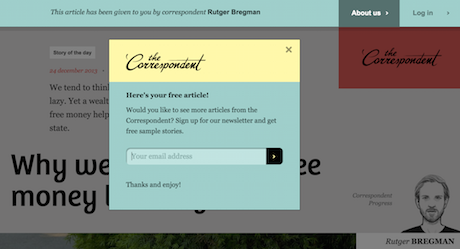
Dutch news website De Correspondent recently passed 40,000 paying subscribers, a little over two years after its launch in 2013.
Since reaching the milestone in mid November, that number has continued to grow and some 42,479 people now pay to read De Correspondent, either on a monthly or yearly basis.
Speaking to Journalism.co.uk, Ernst-Jan Pfauth, De Correspondent’s publisher and co-founder, said the annual membership is the more popular option, with roughly 35,000 people choosing to pay the €60 fee per year.
A monthly subscription plan is also available for €6 – readers are notified one week before their membership is automatically renewed, and are also sent a questionnaire asking for feedback about the platform.
“We don’t see ourselves as an outlet that people follow for a specific kind of story,” Pfauth said.
“Our authors have a lot of freedom, so they can write about whatever they think is important and that’s why you see all these communities emerging on our website.”
Putting the correspondent at the centre of the community
De Correspondent is not a breaking news outlet, so its journalists not only cover traditional topics such as health, education, science and economy, but also niche subjects, like deciphering numbers in polls and other data.
The website’s verticals are organised around each correspondent, rather than the topic he or she covers.I feel that the best way of succeeding is by coming up with new things that serve journalism. But those should be things that you can't replicate in Instant Articles, for example, or Apple NewsErnst-Jan Pfauth, De Correspondent
“The most popular stories are the ones that are constructive,” Pfauth explained, “[stories] that are looking for a solution to a problem.”
The correspondents also bring in the community’s expertise from day one of reporting, rather than present them with the finished product at the end.
In a recent example, the outlet’s economics correspondent wrote a post admitting the occasional difficulties he sometimes faces when dealing with scientific research, and asked people to help via the website and social media.
Over two hundred and seventy people filled in a form about their field of expertise and which correspondent they would like to collaborate with in the future.
Their interest and details are registered in a database that is constantly updated and available to all the journalists in the newsroom.
“One of the key insights for us is that in a traditional newspaper, magazine or website, you hear about an article when it's finished, and that can't happen on our site,” said Pfauth.
“We always have to let people know that an article is coming up. Even if you're just researching something, you should always start with a call to your readers, asking if they know something about it.
“That really worked for us in the sense that our journalism got better, but also the engagement got better, and that’s something we're doing more and more.”
Keeping the conversation alive with informal newsletters
De Correspondent’s journalists also send out newsletters to members of their communities, written and structured in an informal way, and Pfauth said these have a click-through rate of more than 70 per cent.
“Correspondents send out what they're working on, treating [newsletters] like a sort of professional diaries,” he added.
“It's way more personal than on the website, where everything has to be well written and well thought of. In a newsletter, you can really share what you’re working on in a pretty informal way.”In a traditional newspaper, magazine or website, you hear about an article when it's finished, and that can't happen on our siteErnst-Jan Pfauth, De Correspondent
People can subscribe to an individual newsletter and these can sometimes be used as a crowdsourcing method, or to explain the news in a way that resonates better with the audience.
“Our climate editor, for example, wrote about what he's going to do in Paris during the climate change summit, but also asked for tips and explained why this event is actually really important.”
Resurfacing evergreen stories
“Almost all our content is evergreen content,” Pfauth told Journalism.co.uk.
He said De Correspondent will soon be launching a new feature, called ‘it’s relevant again’, in order to highlight older stories as and when they get featured in the news.
When the outlet’s correspondent of conflict and development went to Nepal two years ago and wrote a series of pieces describing how the country was preparing itself for an earthquake, “some people read it, but not a spectacular amount.”
“But then the earthquake happened, we sent out that list of articles again and they were the best articles we’d written at that point, because we had had so much time to prepare,” said Pfauth.
The new feature will consist of resurfacing older stories both on the site’s main feed and on the correspondents’ verticals, but with a label and an updated introduction to explain why the article is relevant again, “using the news as context”.
Tackling the ‘platform wars’
An interesting aspect about De Correspondent’s paywall model is that paying members can share as many articles as they want with their peers, for free.
And what’s more, the editorial team also picks two articles per day, which are also free to read and distributed on Facebook and Twitter.
Pfauth believes that if they chose to limit the amount of articles members can share, “they'd find a way to share it anyhow, either through a screenshot or copy paste, so we'd rather see them [sharing] stories within the concept we think is most effective”.
He said this policy helped De Correspondent build a name for itself, but even though “our content is basically our marketing”, a paradox still exists: converting these occasional readers into paid subscribers.
Every person who reads a member’s recommended article is asked if they would like to sign up to a list that sends them a free article every Saturday, through a pop up box and a call-to-action window at the end of the story.

De Correspondent's pop up box, which appears at the end of an article
Pfauth said roughly two per cent of the people who subscribe to the list become paying members within a few weeks.
“Lots of editors like to talk about the ‘platform wars’, and I feel that the best way of succeeding is by coming up with new things that serve journalism.
“But those should be things that you can't replicate in Instant Articles, for example, or Apple News.
“And one of these elements is, for us, engagement with readers – not in an obligatory, ‘you have to respond to the comments’ way, but really involving them in your journalism.”
Translating and syndicating stories
So what’s next for De Correspondent and can it replicate its success in other markets?
Over the summer, the outlet started building a translation team, to expand its reach to English-speaking audiences, and are also looking to hire an engagement editor for the same team.
“Some of our stories become big hits, but most of the time, it’s about syndication, so we just want to help people discover them somewhere else,” Pfauth said.
The team has already translated a collection of stories and will be sharing one article a week on the website, through separate social media accounts in English and via email to the 2,400 people who have signed up so far.
“This is truly an experiment, but at some point, I imagine that we could use that email list to start a new crowdfunding campaign, for example, but it could also work out totally differently.”
“This is our way of connecting with readers abroad who would like to read more of the journalism we provide in English, because a lot of our stories are relevant to an international audience,” said Pfauth.
Free daily newsletter
If you like our news and feature articles, you can sign up to receive our free daily (Mon-Fri) email newsletter (mobile friendly).
Related articles
- 10 newsletters about AI for journalists
- Black Ballad hits a decade: 'Our priority will always be our community'
- Five key takeaways from the UK select committee on the future of news
- Predictions for journalism 2024: audience-first strategies, formats and products
- Washington Post releases year-in-review feature for subscribers









